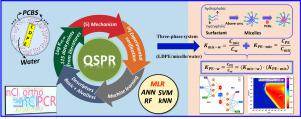Water Research ( IF 12.8 ) Pub Date : 2021-10-25 , DOI: 10.1016/j.watres.2021.117799 Tengyi Zhu 1 , Wenxuan Chen 2 , Yuanyuan Gu 1 , Chad T Jafvert 3 , Dafang Fu 2

|
The water environmental recalcitrance and ecotoxicity caused by polychlorinated biphenyls (PCBs) are international issues of common concern. The partition coefficients with PCBs between low-density polyethylene (LDPE) and water (KPE-w) are significant to assess their environmental transport and/or fate in aquatic environment. Even moderately hydrophobic PCBs, however, possess large KPE-w values, which makes directly experimental measurement labored. Here, based on the combination of quantitative structure-property relationships (QSPRs) and machine-learning algorithms, 10 in-silico models are developed to provide a quick estimate of KPE-w. These models exhibit good goodness-of-fit (R2adj: 0.919–0.975), robustness (Q2LOO: 0.870–0.954) and external prediction performances (Q2ext: 0.880–0.971), providing a speedy feasibility to close data gaps for limited or absent experimental information, especially the RF-2 model. Particularly, an additional experimental verification is performed for models by a rapid and accurate three-phase system (aqueous phase, surfactant micelles and LDPE). The results of the experiments for 16 PCBs show the modeling results agree well with experimental values, within or approaching the residuals of ± 0.3 log unit. Mechanism interpretations imply that the number of chlorine atoms and ortho-substituted chlorines are the great effect parameters for KPE-w. This result also heightens interest in measuring and predicting the KPE-w values of chemicals containing halogen atoms in water.
中文翻译:

多氯联苯的聚乙烯-水分配系数:QSPR 预测模型与实验验证的应用
多氯联苯(PCBs)造成的水环境逆境和生态毒性是国际上普遍关注的问题。PCB 在低密度聚乙烯 (LDPE) 和水 ( K PE-w )之间的分配系数对于评估它们在水生环境中的环境迁移和/或归宿具有重要意义。然而,即使是中等疏水性的 PCB 也具有较大的K PE-w值,这使得直接实验测量变得费力。在这里,基于定量结构-性能关系 (QSPR) 和机器学习算法的组合,开发了 10 个in-silico模型以提供K PE-w的快速估计。这些模型表现出良好的拟合优度 ( R2 adj : 0.919–0.975)、鲁棒性 ( Q 2 LOO : 0.870–0.954) 和外部预测性能 ( Q 2 ext : 0.880–0.971),提供了一种快速的可行性来关闭有限或缺乏实验信息的数据差距,尤其是 RF -2 模型。特别是,通过快速准确的三相系统(水相、表面活性剂胶束和 LDPE)对模型进行了额外的实验验证。16 个 PCB 的实验结果表明,建模结果与实验值非常吻合,在 ± 0.3 log 单位的残差内或接近残差。机理解释意味着氯原子数和邻位取代氯是K的重要影响参数PE-w。这一结果也引起了人们对测量和预测水中含有卤素原子的化学品的K PE-w值的兴趣。


























 京公网安备 11010802027423号
京公网安备 11010802027423号